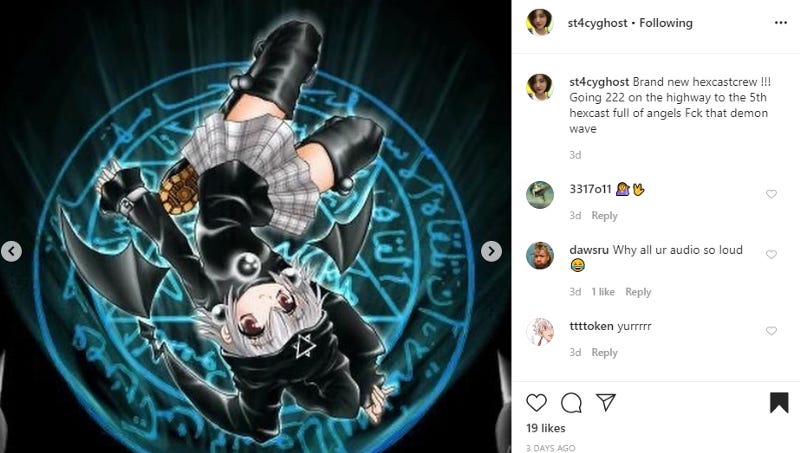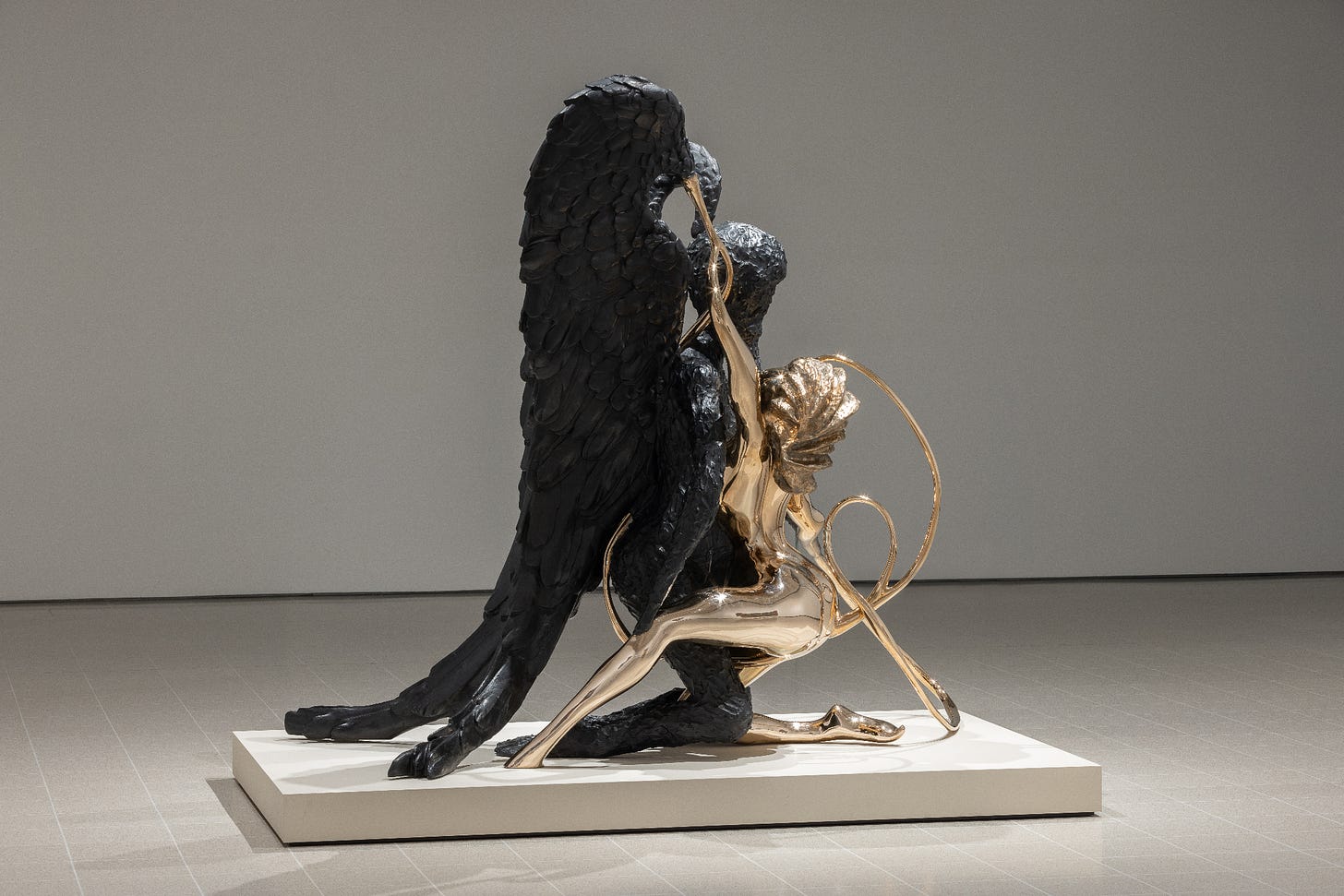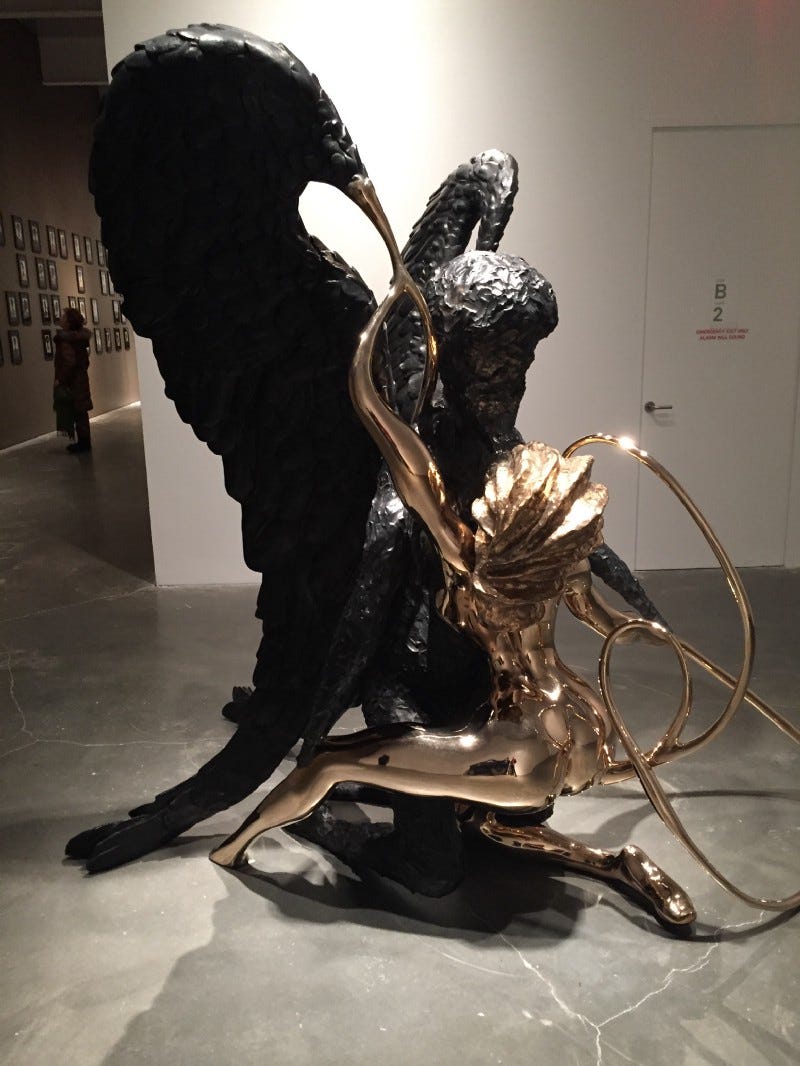SOUNDCLOUD THEORY SUPPLEMENT 01: THE END OF TIME AS CORONA-IMAGE AND THE BIRTH OF ANGELICISM
What is love at the end of time?
1.
Beauty will intensify, complexify AND simplify towards the end, in the end, from the end—at the end of time. The beauty of music may be said to do the same: the beauty of music will intensify, complexify AND simplify towards the end, in the end, from the end—at the end of time; and both beauties, the beauty of beauty at the end, in the end, from the end, and the beauty of music at the end, in the end, from the end, both of them will accelerate, proliferate AND simplify at the end that can be called the end of time.
Since this end larps as historical, we can always go back to find it. In early 2020 a subtle if reliable sign of these multi-chronic claims was that the anime element in the #hex subset seemed to go more viral (see for example #hyperhex on SoundCloud as of February 2020) during the same time that Corona went Chan. The anime-hentai element that was already present in the images that accompanied that music, marking its obscure intra-Sino origins as if behind a bat-eared girl-nurse’s operating mask, threatened to fully denude itself, unbearably, with little indication of a bracing long-term ‘greater health’.
Coronavirus initiated itself as a sign of something gaining unbearable simplicity: a crisis in the aura that China as such is able to represent to the world, a kind of wound to the winning Sinocentric imago, as if an extension of the Sino-American trade war at the level of global reputation-klout and its knocks: China, it turns out, cannot save us either. For a moment, there, the music fully meant that too.
The virus, insofar as it was one, was inherently angelicist: corona actually means ‘crown’ or ‘halo’, so this was also a virality borne on the wings of the homologous and ontogenetic (and not merely analogous) relation of bat and angel. It is as if the bat bit the angel and this is what began to spread in the sound of ‘world music’ as just that, a hex. The music of #hex and what was then #hyperhex already played at the borders of audible bearability, forcing unasked questions about what bearability itself is. If beauty and its music grows, exasperatingly close to and closing itself off at and to the end, exasperating itself at the edges, as just this kind of unbearable end comes closer to itself in us, as what Messiean called infinite slowness, then through what births does bearability push: may I bear, in real fact and music, the images and sounds of actual extinction, which is to say, an end of time in music?
2.
What I’m thinking of is this, which we meant to talk about way back at the beginning.
3.
Ikr. It sounds like an overbirth, an exaggeration. Ikr ikr ikr. The end of time, what could be more dramatic? Yo; but let’s see what the musics say.
It would be no more than foolish to suggest or assume that there are (simply) not enough angels in Dear Angel of Death, or indeed no theoretical organisation around the cherubic at all in this work, and in her later developments on it. For one, look at the title. That’s already a lot. Think it through; that one there (‘dear Angel’) is big with all. Or, in any case, when it comes to an enumeration of literal or illiteral angels, how would one even know? How does one enter an angel and its -icism into the databanks of an ongoing and updated category of aesthetic and transcendental judgement? No angels in this book is like saying no ghosts in plain sight. The fuck would anyone know an angel and its cism is not there. And, equally, how does one read enough to know enough of whether an angel has alighted in a zone of silent inferentiality? Something screeches here, like the sound of #hex and the scrambling/bbling of Messiaen’s stupefied angels (see other supplements), and one has to bear it, all of us now being to some extent what White calls ‘post-expectant’. For White, it seems that if it’s a matter of the angel (the messenger) then it’s a matter of birth (the bearable, the newly born, the new-coded, the new model).
The early sections of her book, Dear Angel of Death, more ‘poetic’, it may be claimed, dictate a code that skips channels between, at the very least, fetus, baby, beloved, stingray, dead father, angel, and impossible place, as well as messenger and (invisible) bubble. It is too much to say the first half of the book is poetical and the second half theoretical, things are much richer than that; and at the start of ‘We Are Here To Slow Time’ for example we are in a space of ‘not considering so much making poems but where poems come from’, marking an indifference of chosen generic container to content. Differently expectant in that way, de-birthing the poem into a snagged abeyance and absence, it’s at this point, for one, that White breaks out the call not just to the angel but to the Angel (‘come, here, Angel’), and this appears more generally in the context of the poems of her actual motherhood (the book partly narrates the birth and presence of White’s child). Do we get the annunciation of a child here, before and as Angel, or the call of the Angel, as and before the child? Who puts up (with) or annunciated who, and why does so much of this feel (in the best possible sense) so rushed, so out of time, so extraordinarily smudged at the edges, so hexed, so forever birthing and channelled? And what if it’s an extinction not a death; and what did you expect?
The final ‘poem’ of the first half of the book is itself (called) ‘Messenger’; but if all this is pushed and born here, why not push on, and push and bear and impress bearability itself, further and still, all the way to the Angel of Extinction, an Hex Angelus that perhaps only a lost and colorless music inexplicably groks or whatever, no longer part of the boy’s club White is slightly mock-jaded by but in which she nonetheless welcomes her kicks? Is there speech for what Eliza Douglas and Anne Imhof call ‘the end of time’? Is it bearable to spell out the enunciation and annunciation of the end of time? Maybe is is, and maybe one can, and maybe one does, and maybe Simone White above all does, and maybe White’s book on the angel of death and ‘remaining in this nothing, which is a category of absolute destruction’, would certainly be the last book to prohibit (and not announce the presence of) a white person (from) inscribing an angel of extinction at the doorstep of the actual end of time, and maybe one can abscond here and bring in Moten who circles at length elsewhere around a certain angelic pair or split that is not necessarily (between) black, brown or whatever constitutes their opposite and opposition.
The pair I really mean are the pair in Ofili’s Annunciation (2006), and one of the many things about this work of art, to start superficially, is that critics often assume the black (matte bronze) angel is copulating with the white (buffed bronze) angel, but actually the buffed one is heavily pregnant (big with something, perhaps phallically so) and so things are slightly more complex, to say the least: perhaps it is more a matter of either intersex, female-female fucking, or perhaps simply not-yet-fucking at all, or even a tentacular embrace without actual holding or carrying; a couple of immaculately inter-passive angels, a black-on-off-white-fuck-caress, a potential non-regenerative 69 (as is announced elsewhere in the same series of works, as if this one were already morphing in the same way that sex often presents itself as chronology, variations, turns, liquidity, and, as we shall see, infinitization). What announces an us here in this expectant beyond of the evisceration of all angelicisms? Black and white continue to call for more refined treatments, as if colour were itself a shock, a political violence, a velveteen wormhole with new taints in it. This is perhaps not at all a black and white scene:
Neither white nor brown, but buffed bronze, this perhaps-receiving but also perhaps-feeding (actively and otherwise) and perhaps-attacking Other Angel, perhaps then a baby angel grown too large for baby form, also evokes and feeds into an almost-horror genre as one finds for example in the exceptional and waiting-to-be-read ‘monster’ sex scenes in Żuławski’s Possession (1981) and Escalante’s The Untamed (2016), milking almost too many associations, sex itself frozen as a gold and bronze anime ticker tape of hieroglyphic angels.
Perhaps the most sexy page of Moten’s all that beauty is the page where he happens to talk about the ‘angle being everything in this absolute tightness, which is angelic, insolvent imposition’. That whole page, the third page of the text ‘mess and mass and (’ [sic] is all about the ‘mess’ and ‘shit’ that art can get away with, this infinite shit of getting and giving an infinite number and qualitative-quantity and list of maybe-messy things that you love. Moten asks: ‘Can you make all that beauty beautiful and give it all away?’ The infinite giving of speeded-up shit, in and at and for and from the end, is what #hex and #hyperhex and even the #coronachanhex of hexcore (as the Idea of a list) can sound and seem like, like all this shit is being given away and imitated because all that beautiful shit is going down and (not) being (not) saved, like the Dzogchen praxis of Tonglen the zenith of which is to be able to take in the suffering of all beings, in all worlds, and to give everything away, everything one thinks one has attained, the end of suffering, enlightenment, utter-completion, whatever it is, all that other shit and beauty, super- and post-expectant, to give it all away, way way out and away: ‘it’s yours now’. Ofili’s Mary Magdalene (Infinity) opens up the space of another angel couple so completely given to something like this self-mutation and kiss, absolute giving away as liquid collapse, that shitting-yourself (through your head?) in mono is almost a beautiful sculptural thing.
That’s a sitting pose? What could be a mutation and liquidification of the angelic couple into an entirely liquid bronze state that separates itself (as Magdalene and not a virgin space of conception), inter-penetrates, extends over itself, enwraps and unwraps itself, and then, like a liquid-list or shitty fist with arms, infinitizes itself in the form of a bracketed title, and (almost and more than) life-form, here sits and rests. One says, simply, ‘(infinity)’. Listing is itself a form of shitty liquid infinity-birthing and infinity-breathing, which is what birth is, an end-point of shit, God getting going getting creation going close to where shit rains down after the fact, infinity doulas. This is what we mean about things getting unbearable, and about the insides of music knowing how to expect this, and about how White’s book — although it sets off everything and pinpoints with fabulous originality and sentential fecundity (like we are riffing on and over, maybe, maybe like the maybe-topped angel) this kind of absolute break in the new music that makes a new music come and to come — also (maybe) doesn’t (quite) liquidate itself into the exting of the hex.
This is what we would have called the birth of angelicism zero one.
2017-2022. See here, and watch out for more supplements.







fabulous